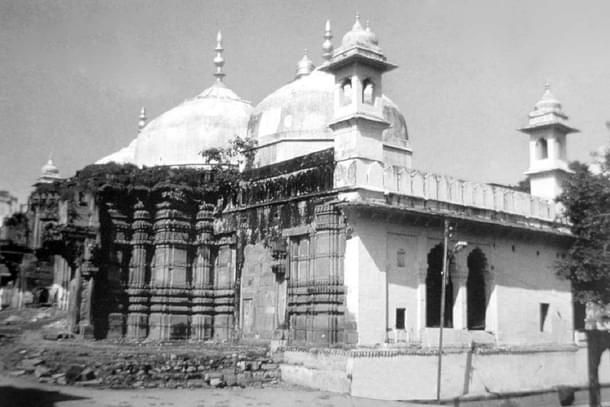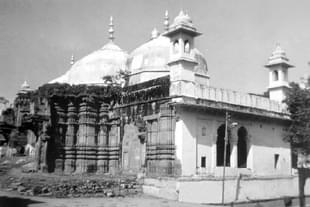Ideas
Gyanvapi – The Moral Question
Venu Gopal Narayanan
May 31, 2022, 07:10 PM | Updated 07:10 PM IST
Save & read from anywhere!
Bookmark stories for easy access on any device or the Swarajya app.


Some months ago, a hubbub broke out in coastal Karnataka when six Muslim girls demanded that they be granted special privileges, as per their religious beliefs, to wear headscarves over their school uniforms. In a flash, the issue metastasised into a fairly acrimonious episode tinged with violence, and developed numerous facets.
Commentary in the press covered the whole gamut, from legality (on whether these schoolgirls’ demand was an essential religious practice or not), to politics, gender, emotion, pedantry, feminism, communalism, constitutionalism, and more.
The same sort of discourse is now developing around the Gyanvapi mosque in Kashi, where, too, arguments have raced off on tangents, after press reports emerged of a Shivalinga having been discovered within the mosque’s premises.
From an initial, absolutist, position that there was no temple there, the arguments have since degenerated to a view that the Shivalinga is, in fact, a fountain.
A convenient cherry-picking of history simultaneously contends that Mughal Emperor Aurangzeb did not order a razing of the Shiva Temple which once stood there. Apparently, that sin has been fobbed off onto a Sultan of the 15th century Sharqui dynasty of Jaunpur, perhaps in the expectation that an absolution of Aurangzeb might help retain the halo he wears in certain circles, and obviate the embarrassing question, of how a mosque came to stand upon Shiva’s well of wisdom (Jnana-vapi).
And, because this is India, the internet is flooded with repulsive memes and remarks from the usual corners, mocking, in flagrant, prurient tones, a strange people who worship a phallic-shaped figure. One former journalist went so far as to ask if the main nuclear reactor building in Trombay would be dug up to determine whether it was a holy site or not, because it resembled a Shivalinga. She deleted the tweet later, and quickly offered an apology of an apology, but the insult was delivered and digestion was achieved. Mission accomplished.
However, like in the Karnataka hijab case, here too, the one question that is not being asked is the moral one. Legality has its place in society, as does emotion, liberalism, or rights, but very few will discuss why it takes so long for Hindus to get back what is rightfully theirs.
A large part of the reason is the heavy covering fire unnecessarily provided to Muslims by the Left Liberal jamaat, most of whom are of Hindu stock even if only in name.
EMS Namboodiripad once gave great credibility to the Communist movement in Kerala, in the 1940s and ‘50s, by running down the aristocratic Nair and Brahmin communities he was related to. Using an adroit mixture of self-loathing and rejectionism, and taking full advantage of discriminatory practices which had taken root over the preceding two centuries, EMS argued that if he, a Brahmin, had no care or need for caste, then why did anyone else?
Times may have changed since then, but the formula remains the same. Today, the loudest proponents of a status quo at Gyanvapi are activists born into privileged Hindu families. Their argument, broadly, is that they are Hindus, and if they have no need for a new temple at the disputed spot, then why should anyone else want one there?
For example, one self-styled public intellectual duly presented his dharmic credentials in veritably rhapsodic terms, before concluding that demands for a temple at Kashi were nothing but attempts at weaponising faith. References to Kumar Gandharva and Pandit Jasraj’s melodic invocations of Shankara set the tone for the punch line – that Lord Shiva didn’t need his protection.
That’s all very well, and admirably poetic, but it is a strawman argument destined for desiccation, because, as all great intellectuals surely know, it was never Lord Shiva who needed protection, but his devotees.
Another disingenuous line of ‘logic’ put forward by the Left-Hindu breed, is that the Left Liberals (as if they are somehow different from their intellectual confederates) will only end up crucifying secularism, by trying to defend Aurangzeb and establish his liberal credentials. This is a tactic so old that it went stale even before India awoke in the 1980s; seizing the moral high ground through sanctimony, and rallying disparate rag-tag militias under a single banner, so that focus doesn’t get clouded.
What’s next? Longer, more rapturous articles gently reminding the world that the Hindu tradition also includes a practice of worshipping a formless god? (The Oachira Shakti in South Travancore could be a good starting point for that argument; there is no idol or temple there, just an empty spot circled by a Banyan tree where devotees come to pray). There’s even a Sanskrit term for such customs – Nirguna Bhakti, and scriptural sanction, so it shouldn’t be too hard to crank out a few pieces on these lines.
The actual pedestrian reality behind such efforts is that the intelligent ones sense that the battle is already lost, and that now, greater emphasis should be on damage control, to mitigate attacks on the narrative, and to prevent a further erosion of their cause. They recognise the nature and magnitude of the grand awakening sweeping across the subcontinent, and are wise enough to realise that at this point of time, hotheads and firebrands to the forefront would only do their revolution more harm than good.
This is not rectitude, but self-preservation. And what is that cause? It’s a palimpsest wrapped in a kaleidoscope: it is political, it is electoral, it is ideological, and above all else, it seeks to ensure that lucrative rice bowls gifted by the ancien regime are not broken.
Aravindan Neelakandan of Swarajya, for example, patiently addressed precisely this cause in a recent piece, wherein he asked why the Muslim community couldn’t junk Nehruvian secularists, and finally, finally, make peace by willingly handing over Kashi and Mathura to the Hindus.
This was supplemented by Smita Barooah, who, in a poignant paean, tried to explain that Hindu sentiments matter as well. Both are wasted efforts, because no matter how passionately, or reasonably, a Neelakandan or a Barooah may argue a case, readers will not hear one word from the ‘Hindu Left’ corner in even partial agreement, or unambiguously castigating those who insultingly compare nuclear reactor domes to a Shivalinga, or dissuading those who insist on washing their hands and spitting in ritual ablution, upon an object sacred to another faith.
The problem is that, boiled down, posing as a Hindu to argue against the Hindu cause is really no different from temple runs, or bandying janeus and gotras during election time. It’s just that political change has forced the pseudo-secularist of yore to devolve into a pseudo-Hindu. And as the French saying goes, the more they change, the more they stay the same!
This desperate hypocrisy, unfortunately, ends up reinforcing a view among Muslims, that if some ‘Hindus’ can live without a temple in Kashi, then surely, those Hindus demanding one are illogical, ignorant and bigoted. It sidelines the spiritual centrality of Kashi rather neatly, while deflecting important questions of history.
It also encourages the Muslim community to take a rigid, defiant, stand, and back that up with long, seemingly-rational arguments on why Muslims ought to keep a mosque built on a temple. The first victim of virtue-signalling is compromise.
This creates a fresh problem, because it then increases Muslim cultural separatism, an escalation of the two-nation mindset, deepens social divides, and trivializes Hindu spiritual needs and aspirations based upon a sacred geography no one can deny.
Just as EMS rejected arguments that you could eradicate social discrimination without eradicating caste identities, today’s jamaat, too, makes the mistake of assuming that a faith can somehow flourish in a vacuum, disconnected from the soil of its birth.
Wrong. Plain wrong. Every Jew will go the Wailing Wall in Jerusalem, because that is a sacred spot which binds the abstract to the real. Every Christian yearns to visit the Church of the Holy Sepulchre, just as every Muslim dreams of praying at Mecca. But for some odd, ideological reason, there are those in India who freely accept the faith-based, earth-bound needs of others, yet seek to deny the same to their own.
This they couch in hushed tones of worry, that raking up the past would create trouble in society. What they don’t understand is that this is not the past; Kashi is a continuum which cannot be denied to those who have believed it so for thousands of years. And what they will never admit – can’t admit – is that these efforts have been the source of our social woes and divides, including the partition of the subcontinent in 1947.
Worse, an ostrich attitude, that conducting a survey to ascertain the truth about the Gyanvapi might open a can of worms, is, in fact, only tightening the lid on a barrel of grievances which has been patiently waiting to burst into the open for generations.
Denying the truth of the Gyanvapi is to deny the civilizational ravages this subcontinent has suffered for almost a thousand years. And yet, this is what has been going on in India for over a century now, garbed and garbled as secularism by some who profess to be Hindus. Consequently, Hindu versus Muslim is, in reality, Hindu versus those of the Left who pose as Hindus. Flaunting one’s atheism is apparently becoming passé in certain circles now.
This creation of an enabling environment by the ‘Hindu Left’ is what emboldens the Ashrafi Muslim (and it is primarily them at the forefront of ensuring nonconformance to the main) to stubbornly refuse any compromise, and intransigently insist that the Gyanvapi be treated only as a mosque, and as a vital spot for their prayers (and their prayers alone), come what may.
Otherwise, do readers really believe that a simple, god-fearing Muslim, left to his own devices, would ever want to offer prayers at the Gyanvapi, knowing full well that his act causes untold pain to those very people amidst whom he ekes out a modest life?
No, of course not. But that is precisely what happened, is happening today, and will continue to happen, until one of two eventualities transpire: either the two-nation theorists and secularists lose their relevance to the Muslims of India, or all three become irrelevant to the fortunes of this land. This is what comes to pass when every question but the moral one is asked.
Venu Gopal Narayanan is an independent upstream petroleum consultant who focuses on energy, geopolitics, current affairs and electoral arithmetic. He tweets at @ideorogue.





